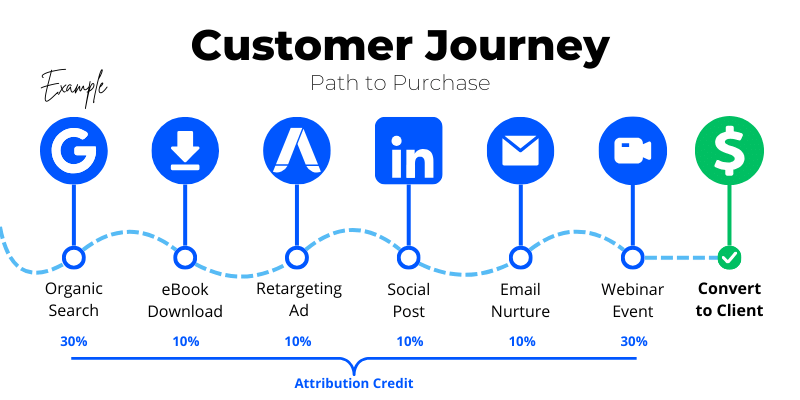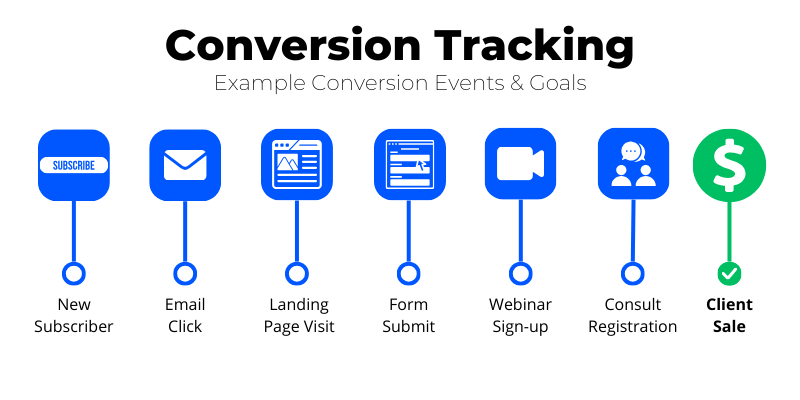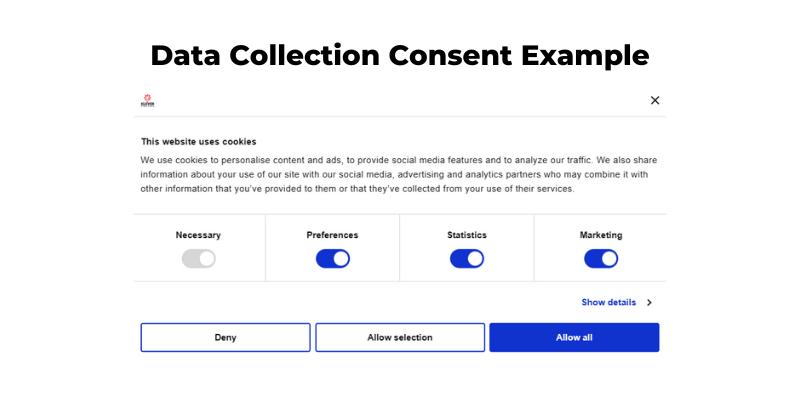Setting up marketing attribution and conversion tracking is essential if you want to increase your return on investment as a business owner. They give you insight into how well different marketing efforts are working for you and give valuable information about your customer’s preferences and behaviors.
- How Does Conversion Tracking Impact ROI?
- Marketing Attribution vs Conversion Tracking: What’s the Difference?
- Marketing Attribution Models
- Key Metrics for Tracking Conversions
- Best Practices for Tracking Across Channels
- Conversion Tracking Setup
- Leveraging UTM Parameters
- Exploring Advanced Techniques
- Integrating CRM with Attribution Tracking
- Addressing Privacy Considerations
- Evaluating Tools for Attribution and Conversion Tracking
- Real-World Examples and Case Studies
- Future Trends in Attribution and Conversion Tracking
Once you understand these concepts, you can begin to skillfully manage your digital marketing strategy.
About Marketing Attribution and Conversion Tracking
Attribution is about matching your marketing tactics to their direct results. For example, if you post about your service offering on social media and a customer clicks on it, visits your website, schedules a consultation, and decides to move forward, you can track it back to the post and attribute your new client to your social media marketing efforts.
Similarly, conversion tracking allows you to measure the results of your marketing campaigns. When you run ads or post on social media, you can track how many people viewed and interacted with your content.
When your conversions are correctly credited to certain interactions with your customers, you can understand how well your campaigns perform and decide which areas to focus on for the highest return on investment.
The concepts of marketing attribution and conversion tracking are extremely important for getting the most out of your valuable marketing dollars – and further, allow you to scale your efforts.
How Does Conversion Tracking Impact ROI?
When you observe and study what users do that leads to hitting certain targets, whether that’s more sales or leads, you can measure what is working and what is not. Customer actions like filling out a form for a consultation or placing an order on your website give you tangible data that can help you improve your returns.
For instance, if you track that most of your sales come from your LinkedIn efforts but your Google ads aren’t doing very well, you can shift your focus to the platform that’s working to avoid wasting money on a strategy that’s not working.
At the same time, you should look into adjusting your Google ads strategy to improve its performance – just because most of your sales are coming from one channel doesn’t automatically mean the other channels should be dismissed.
As a result of allocating your marketing budget to the right places – and identifying tactics that need tweaking and improvements, you will likely see a much higher return on investment.
Marketing Attribution vs Conversion Tracking: What’s the Difference?
Attribution involves giving credit to where your marketing results came from (i.e. ads, social media, referrals), while conversion tracking is watching how users interact with your campaigns and what they do that creates the results you’re seeking.
Both of these ideas are linked, but they have separate roles when it comes to judging how well your marketing tactics are working.
Conversion tracking focuses on the outcome (the conversion) and its direct sources, while attribution focuses on the customer journey and the impact of various touchpoints leading to that outcome.

Overall, attribution takes into account the full journey of a customer, while conversion tracking focuses on certain actions. With attribution, you can gain an understanding of the overall effect of your marketing activities, and conversion tracking gives detailed information about individual conversions from your campaigns.
The Fundamentals of Marketing Attribution Models
Different attribution models provide distinct viewpoints on how a campaign is doing. Here’s an overview:
- First-Click: 100% of the credit goes to the channel with the user’s first click or interaction.
- Last-Click: Credit is given to the last touchpoint the customer engaged with before taking a targeted action like contacting you or making a purchase.
- Linear: A multi-touch model that splits credit evenly between each interaction before the conversion.
- Time Decay: Most of the credit goes to the most recent touchpoint (closest in time to the conversion).
- Position-Based: Also called U-shaped attribution, the first and last touch points each get the majority of the credit, while the rest is given to everything in between.

How Can You Choose the Right Marketing Attribution Model?
Before you choose an attribution model, think about things like your customers’ behavior and what goals you want to achieve from your marketing efforts. Trial and error with different models and analyzing data carefully are important when it comes to finding the best option for your business.
Key Metrics for Tracking Conversions
Several key metrics can help you track marketing conversions. Here’s a quick breakdown:
- Conversion Rate: The number of users who converted out of the total visitors to your website or landing page (ex. 60% of people who clicked on your website made a purchase).
- Cost-Per-Action (CPA): How much you pay for an advertisement that results in a conversion (aka cost-per-acquisition).
- Customer Lifetime Value (CLV): How much a customer spends across their entire relationship with your company.
Tools and Techniques for Measurement
Google Analytics, Google Tag Manager, Facebook Pixel, and other tracking tools have strong functions for following conversions and studying performance data. By using these tools or similar ones, you can make better decisions about where to spend your money and how to improve your results.
Digital Marketing Channels and Attribution
Here are a few of the key digital marketing channels and how you can leverage them:
- Pay-Per-Click (PPC): Paying a fee each time a customer clicks on your advertisement.
- Search Engine Optimization (SEO): Using techniques like keywords on your website to get organic traffic and conversions from online searches.
- Social Media: Using platforms like Instagram, Facebook, and TikTok to promote your product or service.
- Email Marketing: Sending email newsletters to a targeted list of customers with a specific marketing goal in mind.
Best Practices for Tracking Across Channels
Putting in special tracking codes and using analytics tools that are made for each platform is very important to correctly identify which channel leads to sales or desired actions.
Always checking and improving these channels is also necessary to make the most of their performance.
Conversion Tracking Setup
To start tracking for conversions, you will need to set up tracking codes or pixels on the websites and online selling platforms you’re using. Google Analytics and Facebook Business Manager provide easy-to-use interfaces to set up conversion tracking.
For service-based businesses, conversion tracking means monitoring form submissions, landing page visits, items added to the cart, email engagement, attributing offline sales and other important activities that will help you understand your ideal customer’s buyer journey and improve their overall experience on your website.

Leveraging UTM Parameters
UTM parameters can help you follow how well certain campaigns, advertisements, or links are performing. The main types include medium, source, campaign, term, and content. It’s best practice to always include a source, medium, and campaign – while term and content are optional.
Here are three examples of URLs with UTM parameters appended, tailored for different hypothetical marketing campaigns for “example.com”:
1. Social Media Campaign for Brand Awareness

- utm_source=linkedin: Specifies LinkedIn as the traffic source.
- utm_medium=social: Indicates that the medium is social media.
- utm_campaign=brand_awareness: Names the campaign designed to boost brand awareness.
- utm_content=video_ad: Differentiates the content type that was interacted with (a video ad). This is optional.
- utm_term=business_growth: Might be used to identify the focus of the content or targeted keyword. This is optional.
2. Email Campaign for a New Service Launch

- utm_source=newsletter: This identifies the source of traffic as coming from a specific newsletter, providing clarity on which email campaign was successful.
- utm_medium=email: Clearly marks the medium as email, which aligns with Google Analytics’ recognition for accurate tracking and categorization.
- utm_campaign=new_service_launch: Names the specific campaign, allowing for segmentation and analysis of campaign performance.
- utm_content=footer_link: Specifies the exact location of the link within the email, helping to understand which part of the email is more effective in driving clicks. This is optional.
3. PPC Campaign for Course Promotion

- utm_source=google: Indicates traffic is coming from Google.
- utm_medium=ppc: Indicates that the medium is a pay-per-click advertisement.
- utm_campaign=course_promotion: Identifies the campaign targeting course promotion.
- utm_content=ad_version_1: Helps differentiate between versions of the ad. This is optional.
- utm_term=product_keyword: Tracks the keyword used for the PPC campaign. This is optional.
Creating parameters that are clear and organized helps a lot with analyzing and improving these campaigns. For more details, check out our article on how to use UTM parameters.
Analyzing Data from UTM Parameters
When we look at data from UTM parameters, we understand better how campaigns perform, how much the audience is involved, and where conversions come from.
Expert tip: You can view traffic sources, including data from UTM parameters in your Google Analytics 4 “Acquisition” reports.
- Log into Google Analytics 4 and navigate to “Reports” > “Acquisition” > “Traffic acquisition”.
- Within the “Traffic acquisition” report table select “Session source / medium” and/or “Session campaign” to view data corresponding to the utm_source, utm_medium, and utm_campaign parameters.
Using this information based on facts allows marketers to improve who they aim their campaigns at and how they communicate with those audiences for the best outcomes.
Exploring Advanced Techniques
Multi-Touch Marketing Attribution
Multi-touch attribution models give credit to various interactions along the customer’s path, giving a deeper insight into how conversions happen. These models are very useful for businesses that have a longer customer journey.
For example, a service that requires a lot of education for the customer, such as a social media marketing agency, may need multiple interactions with its content before any conversion happens.
Leveraging Machine Learning for Predictive Attribution
Machine learning methods can review large amounts of data to foresee upcoming trends in customer conversions and adjust the spending on marketing based on this. With predictive attribution, companies can be proactive about market movements and make the most of new chances that come up.
Integrating CRM with Attribution Tracking

When you combine CRM systems with tracking of where your customers come from, you can link marketing actions to each customer’s path. This combination gives a full understanding of customer behaviors and preferences.
Tools and Platforms for Integration
CRM systems such as Salesforce and HubSpot can integrate smoothly with online analytics tools, making it easier to monitor campaigns comprehensively and analyze how well they perform. Using these combined functions, you can tailor your marketing strategies better and improve each interaction with customers.
Addressing Privacy Considerations
Since GDPR, CCPA, and more privacy rules have come into effect, it’s more important than ever to put data safety and the protection of customers’ private information first in your marketing efforts. Following these rules is very important for establishing trust and maintaining a good reputation for your brand.
Best Practices for Data Collection
Putting in place clear practices for collecting data, getting users’ direct permission, and offering ways to say no are important steps to follow privacy rules. Providing a short disclosure for contacting your customers via email when they sign up for your newsletter and giving them a clear way to unsubscribe at any time are examples of best practices for marketers.

Evaluating Tools for Attribution and Conversion Tracking
Various platforms, like Google Analytics and Adobe Analytics, provide strong functions for tracking attributions and conversions.
When choosing a platform, it’s important to consider things like price, how much it can grow with your business, and how well it works together with other systems you’re already using. Consider the particular demands of your business, financial limits, and technical needs.
Real-World Examples and Case Studies
Business case studies that show good use of tracking who is buying and why, can teach important lessons and give you ideas for your brand.
Case Study: A professional development coaching firm faced challenges in measuring marketing effectiveness; they struggled to identify which marketing channels and touchpoints were driving qualified leads.
They adopted a multi-touch attribution model, tracking interactions across channels (website, social, email) and integrated their CRM to follow leads from initial inquiry to closing a deal.
By tracking specific events such as case study downloads, webinar sign-ups, and consultation requests, the firm was better able to understand which touchpoints contributed most to conversions.
By implementing conversion tracking and attribution, they achieved the following:
- Clear Attribution: Accurate lead tracking revealed the impact of webinars and personalized consultations.
- Conversion Rate Improvement: Optimizing touchpoints led to a 20% increase in conversion rates over six months.
- Enhanced ROI: Calculating ROI allowed effective resource allocation.
For more details, explore the case study here.
Future Trends in Attribution and Conversion Tracking

AI and Machine Learning
Artificial intelligence and machine learning coming together will change how we understand attribution and track conversions a lot in the future. Using data to predict behaviors, making choices without humans, and focusing on individual customers when targeting ads are some trends that will influence digital marketing in the times ahead.
Evolving Privacy Landscape
While privacy rules keep changing, marketers must change their methods to abide by the law while still giving customers a positive experience. It’s important to always be watchful and ready to adjust when there are new changes in these regulations to keep personal information safe without compromising your campaigns.
Embrace the Power of Attribution and Conversion Tracking
Understanding and using marketing attribution as well as conversion tracking is very important for improving your online marketing results and increasing return on investment. By learning about these ideas and applying the most effective methods to your business, you can discover fresh chances to grow, scale and achieve your goals.
Are you ready to improve your online marketing results? Download our free one-page marketing plan template or contact us to schedule a consultation and start seeing the return on investment you deserve from your marketing campaigns.

